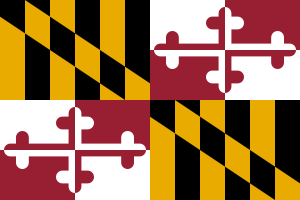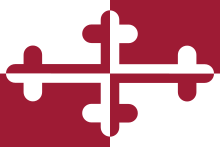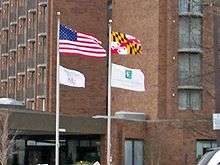Flag of Maryland
 | |
| Use |
Civil and state flag |
|---|---|
| Proportion | 2:3 |
| Adopted | November 25, 1904[1] |
| Design | Heraldic banner of George Calvert, 1st Baron Baltimore |
The official flag of the state of Maryland consists of the heraldic banner of George Calvert, Lord Baltimore (1579–1632). The flag was officially adopted by the Maryland General Assembly in 1904.
Previous design
The first Maryland flag design consisted of the Seal of Maryland on a blue background,[2] similar to many other state flags.
Current design
The black and gold design on the flag is the coat of arms from the Calvert line. It was granted to George Calvert as a reward for his storming a fortification during a battle (the vertical bars approximate the bars of the palisade). The red and white design is the coat of arms of the Crossland line, the family of Lord Baltimore's mother, and features a cross bottony with the red and white sides of the cross alternating. Since George Calvert's mother was a heiress, he was entitled to use both coats of arms in his banner. It is one of only four U.S. state flags that does not contain the color blue (the other three being Alabama, California, and New Mexico). It is also the only US state flag to be directly based on English heraldry, although the flag of Washington, D.C. is a modification of the coat of arms of George Washington's family.
The heraldic blazon is: Quarterly, 1st and 4th, paly of six Or and Sable, a bend counterchanged (for Calvert); 2nd and 3rd, quarterly argent and gules, a cross bottony counterchanged (for Crossland).
History

Unofficial state flag of Maryland used by secessionists/Confederates during American Civil War
The Maryland colony was founded by Cecilius Calvert, second baron and Lord Baltimore (1605–1675), which was granted to him as George's son and heir by King Charles I, hence the use of his family's coat of arms in the flag. At first, only the gold and black Calvert arms were associated with Maryland, being reintroduced in 1854.[3] The red and white colored arms of the Crossland family, which belonged to the family of Calvert's (Lord Baltimore's) paternal grandmother, gained popularity during the American Civil War, during which Maryland remained with the Union despite a large proportion of the citizenry's support for the Confederacy, especially in the central City of Baltimore and the counties of the southern part of the state and the Eastern Shore of the Chesapeake Bay. Those Marylanders who supported the Confederacy, many of whom fought in the Army of Northern Virginia of General Robert E. Lee, adopted the Crossland banner, which was red and white with the bottony (trefoil) cross [3] (seen as "secession colors") and often used a metal bottony cross pinned to their gray uniforms or caps (kepis).. The black and gold (yellow) colors with the chevron design of the Calvert family were used in the flags and devices and uniform pins of the Union Army regiments in the northern Army of the Potomac.
After the war, Marylanders who had fought on either side of the conflict returned to their state in need of reconciliation. The present design, which incorporates both of the coats of arms used by George Calvert, began appearing. At first, the Crossland coat of arms was put in the upper-left corner, but this was supposedly swapped with the Union's Calvert arms because of the Union victory.
The flag in its present form was first flown on October 11, 1880, in Baltimore, at a parade marking the 150th anniversary of the founding of Baltimore (1729–1730). It also was flown on October 25, 1888, at the Gettysburg Battlefield during ceremonies dedicating monuments to the Maryland regiments of the Army of the Potomac by reorganized regiments of the former state militia, now the Maryland National Guard. However, it was not officially adopted as the state flag until 1904.[1][3]
In 2001, a survey conducted by the North American Vexillological Association placed Maryland's flag fourth best in design quality out of the 72 Canadian provincial, U.S. state, and U.S. territory flags ranked.[4]
Legal description

Section 7-202 of the General Provisions Article of the Annotated Code of Maryland provides: "(a) The State flag is divided into quarters. (b) The first and fourth quarters are a paly of six pieces, or (gold) and sable (black), and a bend dexter (right diagonal band) counterchanged, so that they consist of six alternating gold and black vertical bars with a diagonal band on which the colors are reversed. (c) The second and third quarters are quartered argent (white) and gules (red), a cross bottony counterchanged, so that they consist of a quartered field of white and red, charged with a Greek cross that has arms terminating in trefoils and opposite coloring so that red is on the white quarters and white is on the red quarters, as represented on the escutcheon of the State seal."
The Maryland Secretary of State publishes a "Protocol for the Maryland State Flag" which, among other things, specifies the colors of the flag:
1.04. The red and yellow colors in the Maryland flag should conform to the following Pantone Matching System colors:
- red on coated stock: PMS 201
- red on uncoated stock: PMS 193
- yellow on coated stock: PMS 124
- yellow on uncoated stock: PMS 124
Flagpole restrictions
Maryland is the only state in the union that has a specific guideline not only on how to display the flag but on what the flagpole should look like as well. In 1945, the Maryland General Assembly made a gold cross bottony the official ornament for the top of any flagpole carrying the state flag. Some time before October 10, 2007, Government House (the governor's mansion) in Annapolis ceased to display the cross bottony at the top of the flag pole, but the flags at the State House continue to do so (adhering to Maryland Code Section 13-202 and 203). All other state government buildings, including public schools, obey this guideline, but many private individuals and businesses do not.
Cultural impact
The Calvert and Crossland coats of arms, and the flag itself, have been adapted for use in various ways across the state.
- Beginning on September 9, 2008, the University of Maryland painted both end zones at Maryland Stadium with the flag's two patterns.
- Some Maryland counties and municipalities have arms and/or flags incorporating various elements of the arms, including the city of Baltimore, as well as Calvert, Caroline, Baltimore, Howard, and Worcester counties.
- The University of Maryland, College Park athletic teams have long used the colors of the state flag. All four colors from the flag are currently used, with the primary colors being red and white, with black and gold used as accent colors. The Maryland flag is also displayed on the right shoulder of the football uniforms. At the start of the 2011 football season, the team unveiled a new uniform designed by Baltimore-based sportswear company Under Armour combining both parts of the flag. Similarly, the men's lacrosse team features designs from the flag on the jersey shoulders. The end zones of Maryland Stadium are often decorated in a Maryland flag motif, and the state flag is run onto the field during almost all the athletic games.
- The University of Maryland, Baltimore County (UMBC), also in the University System of Maryland, uses all four colors in its main logo.
- The shield of Loyola University Maryland (formerly Loyola College) utilizes both the Calvert shield in its upper-left quadrant, as well as a stylized red and yellow quadrant, symbolic of the Maryland state flag.
- The Baltimore Dragon Boat Club features the flag motif in its logo.
- The seal of The Johns Hopkins University in Baltimore features the same design and colors as the Maryland flag. The Johns Hopkins colors are sable and gold, taken from the Calvert coat of arms (though the athletic colors are blue and white, as the school mascot is the blue jay).
- The secondary logo of the Baltimore Ravens professional football team in the National Football League is a shield with alternating Calvert and Crossland Banners interlocked with a stylized "B" and "R".
- Starting with the 2009 season, the Baltimore Orioles major league baseball club has added a patch to the left arm of their uniforms that features a round version of the Maryland flag.
- The gold and black Calvert coat of arms and red and white Crossland coat of arms are featured in the seal of the town of Ferryland, Newfoundland, present day site of Calvert's Colony of Avalon.
- Southwest Airlines painted a Boeing 737-700 in a Maryland state flag theme in 2005, dubbed Maryland One in recognition of the airline's hub in Baltimore.[5] Southwest Blog entry on Livery Schemes Picture
- Goucher College incorporates the flag in its seal.
- From 1986 to 2010, Maryland's standard issue license plates were white with black lettering and a central seal with the flag's unique design. The 1986 plates are still valid and widely seen after being temporarily replaced by a design commemorating the bicentennial of the War of 1812, which had its Chesapeake Campaign in the state with British attacks on Havre de Grace, and in 1814 with the Battle of Caulk's Field on Maryland's Eastern Shore and with the Battle of Bladensburg with the Burning of Washington and the later Battle of Baltimore/Battle of North Point among other events. A result was the writing of the American national anthem, the "Star Spangled Banner", by Francis Scott Key.[6]
- Many popular culture items feature the flag's design. Crab bumper stickers decorated with the flag are seen on the windshields of cars and many other designs also feature the flag. Shorts, shirts, keychains, and many other items are sold in Maryland and worn by people living in or from the state.
- The flag of the short-lived Republic of Maryland—a state established by the Maryland State Colonization Society to "repatriate" freed slaves in Africa—also used Calvert's black and yellow.
See also
- State of Maryland
- List of Maryland state symbols
- Great Seal of the State of Maryland
- Flag of Montgomery County, Maryland
References
- 1 2 State of Maryland (1904). Chapter 48. Acts of 1904. Maryland: State of Maryland.
effective March 9, 1904
- ↑ Callaham, Art. "The nitty-gritty of Maryland's state flag". HeraldMail.
- 1 2 3 Maryland State Flag History (Maryland Secretary of State.) Retrieved August 29, 2012.
- ↑ Kaye, Edward B. "Good Flag, Bad Flag, and the Great NAVA Flag Survey of 2001". Raven: A Journal of Vexillology. 8. 2001. p. 11-38. Archived from the original on February 23, 2015.
- ↑ Meredith Cohn (June 15, 2005). "Southwest paints Boeing 737 with Maryland flag theme". Baltimore Sun.
- ↑ "Maryland". 15q.net. Retrieved 5 June 2015.
External links
| Wikimedia Commons has media related to Flags of Maryland. |
- History of the Maryland Flag
- Protocol for using the Maryland Flag
- Information from Flags Of The World
- Information from Maryland State Archives